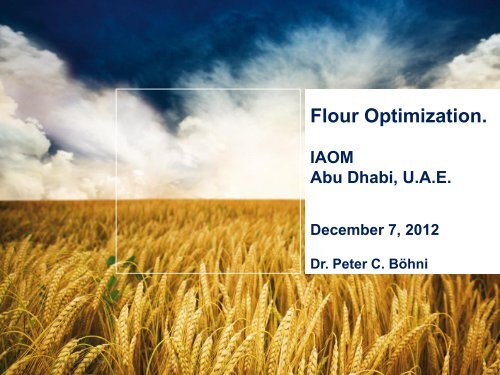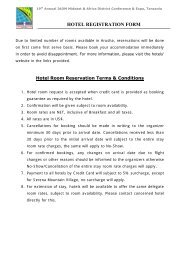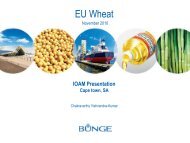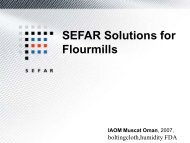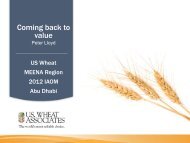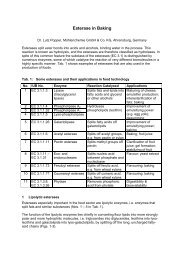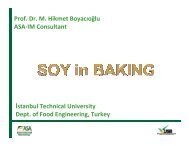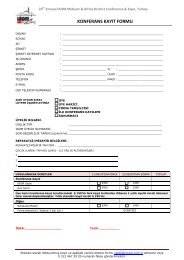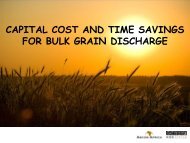How to Optimize Flour Quality
How to Optimize Flour Quality
How to Optimize Flour Quality
Create successful ePaper yourself
Turn your PDF publications into a flip-book with our unique Google optimized e-Paper software.
<strong>Flour</strong> Optimization.<br />
IAOM<br />
Abu Dhabi, U.A.E.<br />
December 7, 2012<br />
Dr. Peter C. Böhni<br />
1 | © Bühler | Milling Technology II 2011
Agenda.<br />
• Optimal <strong>Flour</strong><br />
• Market Challenges and Their Drivers<br />
• Solutions <strong>to</strong> Improve <strong>Flour</strong> <strong>Quality</strong><br />
- Technology: Attrition <strong>Flour</strong><br />
- Ingredients: Gluten functionality<br />
• Food Security - Local Crops (Cassava)<br />
• Summary<br />
2 | © Bühler | <strong>Flour</strong> Optimization, IAOM, Abu Dhabi | Dr. Peter C. Böhni, CDN1 | 2012
Grain <strong>Quality</strong><br />
The Challenge of the Miller.<br />
Constant <strong>Flour</strong> <strong>Quality</strong><br />
Constant flour quality in respect <strong>to</strong> what?<br />
Protein<br />
content<br />
Fiber<br />
content<br />
Shelf<br />
life<br />
Profitability<br />
Dough<br />
stability<br />
Baking<br />
performance<br />
China<br />
EU<br />
Milling<br />
Bakeries<br />
3 | © Bühler | <strong>Flour</strong> Optimization, IAOM, Abu Dhabi | Dr. Peter C. Böhni, CDN1 | 2012
Topics in Western Markets.<br />
Consumer’s View<br />
• Health (obesity, heart health, blood<br />
pressure)<br />
• Convenience<br />
• Clean Label<br />
• Gluten (Celiac Disease)<br />
• Salt Reduction<br />
• Whole grain and Natural Fibers<br />
• Food Safety – Myco<strong>to</strong>xins/Contaminants<br />
4 | © Bühler | <strong>Flour</strong> Optimization, IAOM, Abu Dhabi | Dr. Peter C. Böhni, CDN1 | 2012
Topics in Emerging Markets.<br />
Producer and Consumer Views<br />
• Grain Prices – Availability<br />
• Supply Chain – Logistics<br />
(Losses/wastes)<br />
• <strong>Quality</strong> of Raw Materials<br />
• Import Restrictions - Legislation:<br />
Processing of local raw materials<br />
(Cassava)<br />
• Malnutrition – Hidden Hunger<br />
5 | © Bühler | <strong>Flour</strong> Optimization, IAOM, Abu Dhabi | Dr. Peter C. Böhni, CDN1 | 2012
Grain <strong>Quality</strong><br />
Constant <strong>Flour</strong> <strong>Quality</strong> <strong>to</strong> Meet Cus<strong>to</strong>mer Specifications.<br />
Different Approaches – From Technology <strong>to</strong> Ingredients<br />
Process<br />
Optimization<br />
<strong>Quality</strong><br />
Assurance<br />
<strong>Flour</strong><br />
Correc<strong>to</strong>rs<br />
China<br />
EU<br />
Milling<br />
Bakeries<br />
Milling<br />
Equipment<br />
Sortex,<br />
Cleaning<br />
Systems<br />
Analytics<br />
Perten,<br />
Chopin, …<br />
Handling,<br />
Mixing<br />
6 | © Bühler | <strong>Flour</strong> Optimization, IAOM, Abu Dhabi | Dr. Peter C. Böhni, CDN1 | 2012
Bread dough is a water swollen system based on gluten and<br />
starch.<br />
Approx. composition of 100 g dough<br />
3 g other<br />
8 g protein (gluten)<br />
43 g starch<br />
Gluten is responsible<br />
for dough formation<br />
and gas holding<br />
properties<br />
Starch is<br />
responsible for<br />
bread texture<br />
formation<br />
45 g water (bound by gluten ~ 30 %, and starch ~ 60 % )<br />
7 | © Bühler | <strong>Flour</strong> Optimization, IAOM, Abu Dhabi | Dr. Peter C. Böhni, CDN1 | 2012
Starch plays a key role in bread as texturing agent<br />
Images ETH Zürich (Hug-Iten, 2000)<br />
25 m<br />
10 m<br />
Dough:<br />
limited swelling capacity<br />
of native starch granules<br />
Bread:<br />
extensive swelling of starch<br />
granules leads <strong>to</strong> setting<br />
of bread texture<br />
8 | © Bühler | <strong>Flour</strong> Optimization, IAOM, Abu Dhabi | Dr. Peter C. Böhni, CDN1 | 2012
Attrition <strong>Flour</strong>s for<br />
Higher Water<br />
Absorption.<br />
.
Water uptake as measured with Farinograph [%]<br />
(500 BU, 14 % moisture based)<br />
Attrition <strong>Flour</strong>s.<br />
Higher water absorption through mechanically damaged starch.<br />
■ Damaged starch through<br />
roller mills.<br />
85<br />
■ Grinding pressure<br />
deforms the starch<br />
granule and partly<br />
destroys the crystalline<br />
structure.<br />
■ Damaged starch<br />
granules possess a<br />
higher water retention<br />
capacity<br />
80<br />
75<br />
70<br />
65<br />
60<br />
R² = 0.755<br />
5 10 15 20 25<br />
Starch damage AACC 76-30.02 [%] (dry matter based)<br />
10 | © Bühler | <strong>Flour</strong> Optimization, IAOM, Abu Dhabi | Dr. Peter C. Böhni, CDN1 | 2012
Attrition <strong>Flour</strong>s.<br />
System comparison of ball mill system versus roller mill.<br />
Ball mill system<br />
Fine Grinding<br />
Impact Mill<br />
MJPB<br />
11 | © Bühler | <strong>Flour</strong> Optimization, IAOM, Abu Dhabi | Dr. Peter C. Böhni, CDN1 | 2012
Attrition <strong>Flour</strong>s.<br />
Attrition flour from coarse semolina.<br />
■ Semolina reduction with high grinding pressure.<br />
■ Fine Impact Mill MJPB for detaching flakes.<br />
■ Mechanically damaged starch absorbs five times more water than intact starch!<br />
12 | © Bühler | <strong>Flour</strong> Optimization, IAOM, Abu Dhabi | Dr. Peter C. Böhni, CDN1 | 2012
Attrition <strong>Flour</strong>s.<br />
Increase of water absorption by addition of attrition flour.<br />
Product<br />
Water<br />
absorption<br />
[14% Basis]<br />
Starch<br />
damage<br />
[%]<br />
Standard flour type 550 62.6 9.9<br />
Attrition flour processed with roller mill and<br />
Fine Grinding Impact Mill Type MJPB<br />
87.8 25.5<br />
Blend of 92% standard flour 550 and<br />
8% attrition flour<br />
65.1 11.0<br />
13 | © Bühler | <strong>Flour</strong> Optimization, IAOM, Abu Dhabi | Dr. Peter C. Böhni, CDN1 | 2012
Formulations – Attrition <strong>Flour</strong><br />
Positive Effects on Bread Production<br />
Ingredients Trial 1<br />
[g]<br />
Trial 2<br />
[g]<br />
Δ<br />
[%]<br />
Trial 3<br />
[g]<br />
<strong>Flour</strong> type 550 1000 950 950<br />
Attrition flour - 50 5 50<br />
Water 650 660 1.5 660<br />
Salt 20 20 20<br />
Yeast 30 30 30<br />
<strong>Flour</strong>zyme - - 1.00<br />
Total 1700 1710 0.6 1711<br />
14 | © Bühler | <strong>Flour</strong> Optimization, IAOM, Abu Dhabi | Dr. Peter C. Böhni, CDN1 | 2012
[ml/100g]<br />
bread<br />
Specific Volume<br />
Attrition <strong>Flour</strong><br />
500<br />
450<br />
400<br />
+3.8%<br />
+16.6%<br />
350<br />
300<br />
250<br />
200<br />
150<br />
388 403 453<br />
100<br />
50<br />
0<br />
0 sample, flour type 550 <strong>Flour</strong> type 550 + 5% Attrition flour <strong>Flour</strong> type 550 + 5% Attrition flour +<br />
0.1%<strong>Flour</strong>zme<br />
15 | © Bühler | <strong>Flour</strong> Optimization, IAOM, Abu Dhabi | Dr. Peter C. Böhni, CDN1 | 2012
Specific Volume – Texture<br />
Breads with 5% Attrition <strong>Flour</strong><br />
1: <strong>Flour</strong> Type 550<br />
2: <strong>Flour</strong> Type 550 + 5% attrition flour<br />
3: <strong>Flour</strong> Type 550 + 5% attrition flour<br />
+ 0.1% <strong>Flour</strong>zyme<br />
16 | © Bühler | <strong>Flour</strong> Optimization, IAOM, Abu Dhabi | Dr. Peter C. Böhni, CDN1 | 2012
Attrition <strong>Flour</strong>s for Higher Water Absorption.<br />
Summary.<br />
■ Attrition passages increase flexibility and<br />
can add value <strong>to</strong> your flour by<br />
Increased water absorption<br />
Higher dough yield<br />
Improved bread volume<br />
Extended shelf life<br />
■ Attrition process via roller mill is an<br />
economical solution. It is user-friendly and<br />
requires little maintenance.<br />
The simple value-added process for a flexible milling operation<br />
17 | © Bühler | <strong>Flour</strong> Optimization, IAOM, Abu Dhabi | Dr. Peter C. Böhni, CDN1 | 2012
Bread dough is a water swollen system based on gluten and<br />
starch.<br />
Approx. composition of 100 g dough<br />
3 g other<br />
8 g protein (gluten)<br />
43 g starch<br />
Gluten is responsible<br />
for dough formation<br />
and gas holding<br />
properties<br />
Starch is<br />
responsible for<br />
bread texture<br />
formation<br />
45 g water (bound by gluten ~ 30 %, and starch ~ 60 % )<br />
18 | © Bühler | <strong>Flour</strong> Optimization, IAOM, Abu Dhabi | Dr. Peter C. Böhni, CDN1 | 2012
Wheat Protein Content for Different Applications<br />
Variety Breads<br />
Hearth Breads<br />
Pasta & Egg Noodles<br />
Sandwich Breads<br />
General Purpose <strong>Flour</strong>s<br />
Asian Noodles<br />
Crackers<br />
Pie Crusts & Doughnuts<br />
HW<br />
Cookies<br />
Cakes<br />
SRW<br />
HRW<br />
HRS/Durum<br />
SW<br />
8 9 10 11 12 13 14 15 16<br />
% Protein<br />
19 | © Bühler | <strong>Flour</strong> Optimization, IAOM, Abu Dhabi | Dr. Peter C. Böhni, CDN1 | 2012
Improvement of Gluten <strong>Quality</strong> and Performance<br />
• Wheat of a good gluten quality resulting in<br />
an optimal baking performance is<br />
expensive.<br />
• The addition of vital wheat gluten can<br />
deliver a better baking performance, but<br />
can be costly<br />
• <strong>Flour</strong>zyme – improves the baking<br />
performance of low–protein flours and<br />
• <strong>Flour</strong>zyme – Omits the use of vital<br />
wheat gluten<br />
20 | © Bühler | <strong>Flour</strong> Optimization, IAOM, Abu Dhabi | Dr. Peter C. Böhni, CDN1 | 2012
Formulations<br />
Gluten Replacement<br />
Ingredients Trial 1 [g] Trial 2 [g] Trial 3 [g]<br />
<strong>Flour</strong> type 550 2000 1960 2000<br />
Water 1250 1250 1250<br />
Yeast 60 60 60<br />
Salt 40 40 40<br />
Dry Gluten - 40 -<br />
<strong>Flour</strong>zyme - - 2<br />
Total 3350.00 3350.00 3352.00<br />
21 | © Bühler | <strong>Flour</strong> Optimization, IAOM, Abu Dhabi | Dr. Peter C. Böhni, CDN1 | 2012
[ml/100g]<br />
bread<br />
Specific Volume<br />
Gluten Replacement<br />
500<br />
+55.8%<br />
450<br />
400<br />
350<br />
+8.8%<br />
300<br />
250<br />
200<br />
150<br />
304.3 331.2 474.0<br />
100<br />
50<br />
0<br />
0 sample, flour type 550 <strong>Flour</strong> type 550 + 2% dry Gluten <strong>Flour</strong> type 550 + <strong>Flour</strong>zyme<br />
22 | © Bühler | <strong>Flour</strong> Optimization, IAOM, Abu Dhabi | Dr. Peter C. Böhni, CDN1 | 2012
Specific Volume - Texture<br />
Gluten Replacement<br />
23 | © Bühler | <strong>Flour</strong> Optimization, IAOM, Abu Dhabi | Dr. Peter C. Böhni, CDN1 | 2012
Cost Benefit<br />
Gluten Replacement<br />
Saving<br />
11 EUR/MT<br />
24 | © Bühler | <strong>Flour</strong> Optimization, IAOM, Abu Dhabi | Dr. Peter C. Böhni, CDN1 | 2012
Food Security<br />
Policies <strong>to</strong> substitute Cassava <strong>Flour</strong> for Wheat <strong>Flour</strong> in Nigeria<br />
• The Government of Nigeria plans <strong>to</strong> cut wheat<br />
imports by introducing a new policy compelling<br />
cassava flour inclusion in wheat flour.<br />
• Their plan is <strong>to</strong> impose a levy of 15% on wheat<br />
imports, increasing the duty from 5% <strong>to</strong> 20%.<br />
• A fiscal incentive is introduced <strong>to</strong> stimulate<br />
domestic production and processing of cassava.<br />
• Implementation has started in March 2012 with 10%<br />
cassava flour inclusion in wheat flour.<br />
• The inclusion rate is expected <strong>to</strong> increase steadily <strong>to</strong><br />
40% cassava by 2015.<br />
25 | © Bühler | <strong>Flour</strong> Optimization, IAOM, Abu Dhabi | Dr. Peter C. Böhni, CDN1 | 2012
Formulation<br />
Bread without and with 10% Cassava <strong>Flour</strong><br />
Ingredients Trial 1 [g] Trial 2 [g] Trial 3 [g]<br />
<strong>Flour</strong> type 550 1000 900 900<br />
Cassava flour - 100 100<br />
Water 640 640 640<br />
Yeast 30 30 30<br />
Salt 20 20 20<br />
Sugar 100 100 100<br />
Vegetable Fat 10 10 10<br />
<strong>Flour</strong>zyme - - 2<br />
Total 1800 1800 1802<br />
26 | © Bühler | <strong>Flour</strong> Optimization, IAOM, Abu Dhabi | Dr. Peter C. Böhni, CDN1 | 2012
[ml/100g]<br />
bread<br />
Specific Volume<br />
Volume development without and with 10% Cassava <strong>Flour</strong><br />
500<br />
450<br />
400<br />
350<br />
-5.7%<br />
+11%<br />
300<br />
250<br />
200<br />
150<br />
339 320<br />
377<br />
100<br />
50<br />
0<br />
0 sample, flour typpe 550 <strong>Flour</strong> type 550 + 10% Cassava <strong>Flour</strong> type 550 + 10% Cassava +<br />
0.2% <strong>Flour</strong>zyme<br />
27 | © Bühler | <strong>Flour</strong> Optimization, IAOM, Abu Dhabi | Dr. Peter C. Böhni, CDN1 | 2012
Product Applications<br />
Bread with 10% Cassava <strong>Flour</strong><br />
1: <strong>Flour</strong> Type 550<br />
2: <strong>Flour</strong> Type 550 + 10% cassava<br />
3: <strong>Flour</strong> Type 550 + 10% cassava<br />
+ 0.2% <strong>Flour</strong>zyme<br />
28 | © Bühler | <strong>Flour</strong> Optimization, IAOM, Abu Dhabi | Dr. Peter C. Böhni, CDN1 | 2012
Product Applications<br />
Bread with Cassava<br />
• Inclusion of cassava flour in<strong>to</strong><br />
wheat flour up <strong>to</strong> about 20%<br />
could still give an acceptable<br />
fresh loaf depending on the<br />
source of wheat flour.<br />
Bread on display for sale in Nigeria<br />
29 | © Bühler | <strong>Flour</strong> Optimization, IAOM, Abu Dhabi | Dr. Peter C. Böhni, CDN1 | 2012
Product Applications<br />
Pasta with Cassava<br />
• Wheat flour blended with 10% native cassava flour had no<br />
negative effect on cooking properties or texture firmness<br />
• The sample with 10% cassava had a less sticky surface when<br />
compared with 100% wheat flour<br />
• Cooking loss as well as firmness of the texture were<br />
significantly influenced by addition of 25 or 40% cassava flour.<br />
Trials Cooking loss Texture analysis<br />
Technology - Sample<br />
Starch release<br />
E-value<br />
[%]<br />
[mJ]<br />
Polymatik - 0% Cassava 4.7 0.7380<br />
Polymatik - 10% Cassava 4.6 0.7380<br />
Priomatik - 25% treated Cassava 5.6 0.5350<br />
30 | © Bühler | <strong>Flour</strong> Optimization, IAOM, Abu Dhabi | Dr. Peter C. Böhni, CDN1 | 2012
Summary<br />
Optimization of <strong>Flour</strong> <strong>Quality</strong><br />
• Optimal and constant flour quality<br />
requires know-how in:<br />
- Technology<br />
- Processes<br />
- Biochemistry and<br />
- Applications<br />
• Cus<strong>to</strong>mer Value<br />
- Innovations for the marketplace.<br />
- Higher-value products through new<br />
processes or ingredients.<br />
- Upgrading of by-products.<br />
- Development of new market<br />
segments.<br />
Application<br />
Know-how<br />
Technology<br />
Process<br />
Nutrition<br />
Health<br />
Ingredients<br />
31 | © Bühler | <strong>Flour</strong> Optimization, IAOM, Abu Dhabi | Dr. Peter C. Böhni, CDN1 | 2012
Team:<br />
Thank you!<br />
Matthias Furrer<br />
Patrick Soltermann*<br />
Chris Lemaire<br />
Saghi Mohamadi*<br />
Walter von Reding<br />
Manfred Dirndorfer*<br />
32 | © Bühler | Milling Technology II 2011


